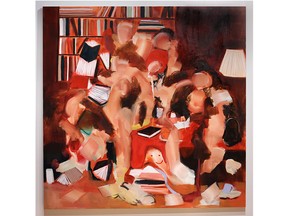Reviews and recommendations are unbiased and products are independently selected. Postmedia may earn an affiliate commission from purchases made through links on this page.
Art
Q+A: London artist on how liberation, sensuality inspire her oil paintings

London artist Angie Quick is having her second solo exhibition – Smoke Gets In Your Eyes – at the Michael Gibson Gallery until Feb. 24. The 35-year-old self-taught painter, who moved to London from Calgary at age 18, spoke with LFP’s Beatriz Baleeiro about the local art scene and her new show.
It was taken from the song, a recorded version sung by Bryan Ferry. My parents would play it a lot when I was little. Usually, for my shows, I title the paintings from very personal lines but for this one, I decided to title each painting with a lyric from that song. It’s a song about being naive and putting your whole self out there and then having your heart broken, not just romantically, but in all sorts of aspects of life.
Your work is described as “seductive paintings that explore notions of happiness and joy, love.” Can you explain what ‘seductive’ means in your work?
Within the body of work that I make, there’s always a kind of sexual tension or eroticism, whether I’m actually depicting the naked body or I’m implying it, but I think the best way to describe my work is sensual. For me, sensuality is like how I paint, with oil paint. I think the very act of using and how I use oil paint is very sensual, and it has a tactile feel to it. So, when someone looks at it, it’s like they can feel the brushwork and emotion of me making the work. I think that has a luscious sensuality. I’d also say erotic, because if you look at them, there is a sense of the naked body and maybe you’re not sure what part of the body you’re looking at.

Where does your interest in eroticism as part of your work come from?
I would say that my interest in sensuality and eroticism is because we all come from a sexual nature. And, I think I’m interested in breaking down the idea between what it is to be the authority of being human, but then what it means to be an animal. I think when we strip away the idea of like that being human is better, it’s actually that we’re all just animals.
What’s your journey as an artist in London been like so far?
I really like working in London. From being a very young artist to now, there are a lot of interesting art groups and people doing stuff, but I think sometimes London gets seen as just a small city, which it is, but I think there’s an eagerness that exists in the city for people to make a space for creatives, so I’ve always really appreciated that.
Where do you find inspiration in the city?
I find London itself inspiring because it’s a city that is kind of bare-bones. It doesn’t really hide the ugliness of the city. By ugliness, I’d say where society fails and I think that’s an important thing is for young people and for artists to always be aware of where we have to do better. For me, art is important because it allows for that kind of dialogue and communication about what it is to be alive.

In your opinion, how’s the art scene in London? Is there space for another generation of artists?
It’s a great city with a lot of young people working really hard and having a vision. There’s a strong group of young people pushing for a space that allows for more women, queer, people of colour, and different kinds of background representation. I’m a big proponent and I love the young artists in London. There’s a real sense of community in London and wanting to push and a lot of the young artists have a huge political message with their work, too, and I think that’s really important to have.
Do you also have a political message that translates into your work?
I’d say a lot of my work deals with the idea of liberation, what that looks like and how freedom pushes against certain paradigms.
What are your expectations for the exhibit and as an artist?
I think it’s just like an opportunity to get to further share my vision and the work. The more people I think that get to see the paintings, the broader the dialogue that happens. And I think that’s really good for the paintings to kind of, like, live a bigger life. I see myself painting and making more work and hopefully exhibiting, further and wider outside of just Canada.

Art
40 Random Bits of Trivia About Artists and the Artsy Art That They Articulate – Cracked.com
[unable to retrieve full-text content]
40 Random Bits of Trivia About Artists and the Artsy Art That They Articulate Cracked.com

Source link
Art
John Little, whose paintings showed the raw side of Montreal, dies at 96 – CBC.ca
[unable to retrieve full-text content]
John Little, whose paintings showed the raw side of Montreal, dies at 96 CBC.ca

Source link
Art
A misspelled memorial to the Brontë sisters gets its dots back at last

LONDON (AP) — With a few daubs of a paintbrush, the Brontë sisters have got their dots back.
More than eight decades after it was installed, a memorial to the three 19th-century sibling novelists in London’s Westminster Abbey was amended Thursday to restore the diaereses – the two dots over the e in their surname.
The dots — which indicate that the name is pronounced “brontay” rather than “bront” — were omitted when the stone tablet commemorating Charlotte, Emily and Anne was erected in the abbey’s Poets’ Corner in October 1939, just after the outbreak of World War II.
They were restored after Brontë historian Sharon Wright, editor of the Brontë Society Gazette, raised the issue with Dean of Westminster David Hoyle. The abbey asked its stonemason to tap in the dots and its conservator to paint them.
“There’s no paper record for anyone complaining about this or mentioning this, so I just wanted to put it right, really,” Wright said. “These three Yorkshire women deserve their place here, but they also deserve to have their name spelled correctly.”
It’s believed the writers’ Irish father Patrick changed the spelling of his surname from Brunty or Prunty when he went to university in England.
Raised on the wild Yorkshire moors, all three sisters died before they were 40, leaving enduring novels including Charlotte’s “Jane Eyre,” Emily’s “Wuthering Heights” and Anne’s “The Tenant of Wildfell Hall.”
Rebecca Yorke, director of the Brontë Society, welcomed the restoration.
“As the Brontës and their work are loved and respected all over the world, it’s entirely appropriate that their name is spelled correctly on their memorial,” she said.
The Canadian Press. All rights reserved.
-

 News22 hours ago
News22 hours agoTrudeau, Freeland embrace a second Trump presidency
-

 News22 hours ago
News22 hours agoIn this Florida school district, some parents are pushing back against a cellphone ban
-

 News12 hours ago
News12 hours agoA tiny grain of nuclear fuel is pulled from ruined Japanese nuclear plant, in a step toward cleanup
-

 News22 hours ago
News22 hours agoThings for Canada to watch following Trump victory in U.S.
-

 Economy21 hours ago
Economy21 hours agoHealth-care spending expected to outpace economy and reach $372 billion in 2024: CIHI
-

 News12 hours ago
News12 hours agoCanadanewsmedia news November 07, 2024: Canada’s health-care spending to reach $372 billion in 2024
-

 Sports12 hours ago
Sports12 hours agoDeMar DeRozan scores 27 points to lead the Kings past the Raptors 122-107
-

 Sports12 hours ago
Sports12 hours agoPWHL unveils game jerseys with new team names, logos





















